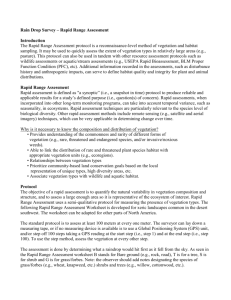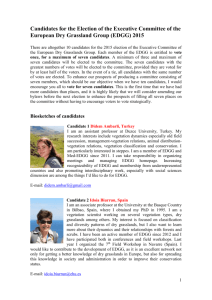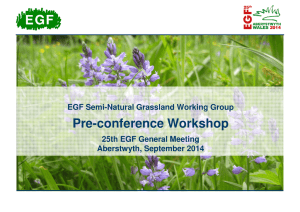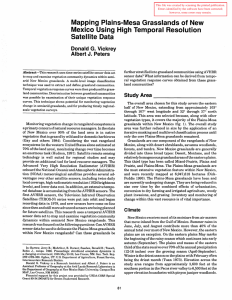SOCArtx
advertisement
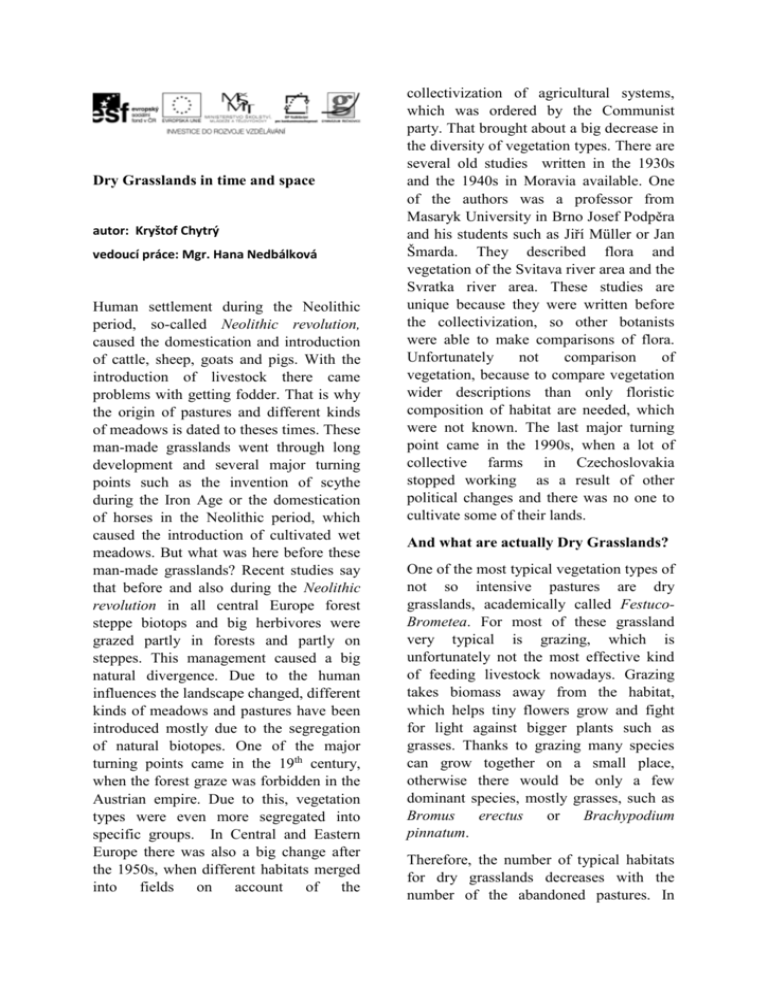
Dry Grasslands in time and space autor: Kryštof Chytrý vedoucí práce: Mgr. Hana Nedbálková Human settlement during the Neolithic period, so-called Neolithic revolution, caused the domestication and introduction of cattle, sheep, goats and pigs. With the introduction of livestock there came problems with getting fodder. That is why the origin of pastures and different kinds of meadows is dated to theses times. These man-made grasslands went through long development and several major turning points such as the invention of scythe during the Iron Age or the domestication of horses in the Neolithic period, which caused the introduction of cultivated wet meadows. But what was here before these man-made grasslands? Recent studies say that before and also during the Neolithic revolution in all central Europe forest steppe biotops and big herbivores were grazed partly in forests and partly on steppes. This management caused a big natural divergence. Due to the human influences the landscape changed, different kinds of meadows and pastures have been introduced mostly due to the segregation of natural biotopes. One of the major turning points came in the 19th century, when the forest graze was forbidden in the Austrian empire. Due to this, vegetation types were even more segregated into specific groups. In Central and Eastern Europe there was also a big change after the 1950s, when different habitats merged into fields on account of the collectivization of agricultural systems, which was ordered by the Communist party. That brought about a big decrease in the diversity of vegetation types. There are several old studies written in the 1930s and the 1940s in Moravia available. One of the authors was a professor from Masaryk University in Brno Josef Podpěra and his students such as Jiří Müller or Jan Šmarda. They described flora and vegetation of the Svitava river area and the Svratka river area. These studies are unique because they were written before the collectivization, so other botanists were able to make comparisons of flora. Unfortunately not comparison of vegetation, because to compare vegetation wider descriptions than only floristic composition of habitat are needed, which were not known. The last major turning point came in the 1990s, when a lot of collective farms in Czechoslovakia stopped working as a result of other political changes and there was no one to cultivate some of their lands. And what are actually Dry Grasslands? One of the most typical vegetation types of not so intensive pastures are dry grasslands, academically called FestucoBrometea. For most of these grassland very typical is grazing, which is unfortunately not the most effective kind of feeding livestock nowadays. Grazing takes biomass away from the habitat, which helps tiny flowers grow and fight for light against bigger plants such as grasses. Thanks to grazing many species can grow together on a small place, otherwise there would be only a few dominant species, mostly grasses, such as Bromus erectus or Brachypodium pinnatum. Therefore, the number of typical habitats for dry grasslands decreases with the number of the abandoned pastures. In Central Europe there are many active groups of nature protection, for example the Czech Union for Nature Conservation. These groups are trying to save as many dry grasslands as possible, using artificial management, which is not economically profitable. Many of Nature Consevation organizations also publish studies dealing with the problems of nature conservation. Ecology in numbers With the big development of computer technology in the last 40 years there also came progress in statistical methods used in science. Thanks to computer programmes people are able to compare huge datasets. With such a development statistical methods became more requisite. Scientists working in the field are trying to focus on taking data suitable for these methods. For this work I had to make phytocenological releves, which are lists of species growing on homogeneous area of the same size within all dataset (for this work it was 25 m2). Data taken in the field were rewritten into the database with data taken in the field in past. Same statistical analysis made on the dataset distributed all releves in the entering analysis by their rate of difference. These analyses are called corespondence analyses and now they are the base of all big researches working with extremely big datasets. Vegetation change, despite we do not see it In the middle Svitava area one of typical dry grassland habitats named by Czechoslovakian Botanist J. Müller in 1948 Svahy u Černé Hory is situated. This habitat can be used as analogical for most of dry grassland habitats in the Svitava area and eventually also the Svratka area. Factors in which they are similar are calculous minerals, the similar composition of the flora, the same or very similar vegetation types and the history of management. In the middle Svitava area and in all Central Europe the abandonment was caused by the simple fact that people did not want to care of livestock themselves and neither they do nowadays. Furthermore, the termination of grazing on such dry grassland habitats resulted in expanding shrub species such as dogwood (Cornus sanguinea) or blackthorn (Prunus spinosa). This degradation of the dry grassland vegetation went so far in some parts of this habitat that the vegetation type was changed into forest with dominant pine (Pinus sylvestris) and oak (Quercus petrea). The situation of this degradation was examined in 2013, thirty years after the vegetation research was held there. The same comparing analysis was made on data taken in 1983 and 2013. One of them was the analysis comparing all data’s floristic compositions. This analysis called Detrended corespondence analysis shows that old and new datasets are different. The new dataset is more compact, so we can say that vegetation is more similar in different parts of the habitat. Another vegetation change evident from the analysis is a huge decrease of dry grassland species and expanding of shrub and forest species into the dry grasslands vegetation. We cannot reckon if vegetation of dry grasslands in this habitat will extinguish, but with no suitable management in near future there can appear recognizable important changes… And the sad truth is that while people forget their traditions dry grasslands disappear.






